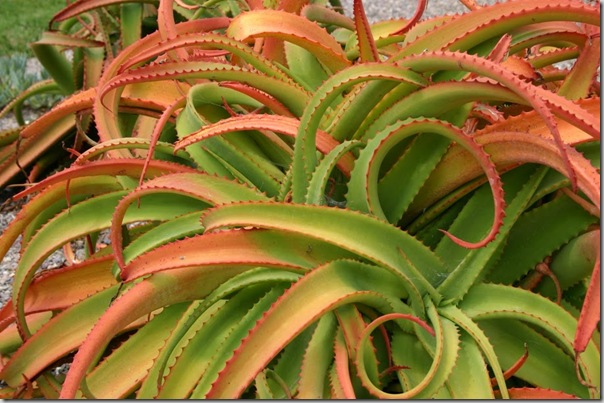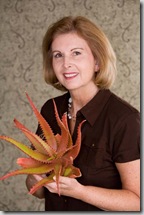Two weeks ago, I reviewed the popular, and deservedly so, Succulent Container Gardens by Debra Lee Baldwin. I think of Debra as a real advocate for these plants, because she shows such elegant ways of designing with them that we all want to grow these colorful, varied plants ourselves. And so we should! They’re low-water, low-maintenance, and can be easily divided and given to other gardeners, creating friendships along with year-round garden displays.
Debra’s story of how she came to love succulents shows the engaging writing voice she is known for, and reflects the many reasons you might wish to grow succulents as well.

Read on for an excerpt from the preface of Designing with Succulents:
Succulent describes any plant that survives drought by storing water in its leaves, stems, or roots. When I was a child, such smooth, plump plants reminded me of modeling clay, and their shapes of stars, beads, and jelly beans. As I grew older, I equated succulents with jade plants that thrive in abandoned gardens and were removed by people who were serious about landscaping.
Succulents were far from my mind when I began gardening in 1990. Because I wanted big, bold, beautiful flowers, I cultivated tropical cannas, and roses and fluffy perennials that hearkened to English gardens—never mind that inland Southern California (USDA zone 9) was subject to frost, 100-degree heat, rain that falls minimally (and mostly in February), and the soil is decomposed granite, poor in organic matter. At one time I had more than a dozen varieties of cannas and 75 rosebushes, all of which required endless amending, mulching, fertilizing, pruning, spraying, irrigating, and deadheading. I still would be doing all that it if my work had not introduced me to people who view gardening as an endeavor that ought to suit the region.
My job as a garden and design writer is to define and describe beauty. Whether I am touring a showcase house or a notable garden, I strive to find what makes the environment appealing. Architects, landscapers, and homeowners who design such settings dissect them for me, so my readers can learn their secrets.
In midwinter of 1999, when my garden consisted of pruned, leafless rosebushes; brown-leaved cannas; and perennials that had been cut to the ground, I was asked to write a story about Patrick Anderson’s garden, located in Fallbrook, California, midway between Los Angeles and San Diego. That day in December his garden was lush and colorful, despite its decomposed granite soil and lack of automatic irrigation.
“Fleshy green monsters in Patrick Anderson’s Fallbrook garden look like they might snap him up if he turns his back,” my article began. “They’re giant succulents, and Anderson’s half-acre hillside showcases hundreds of unusual ones.” The story went on to describe aloes that “pierce the sky like exotic torchbearers, hot orange against cool blue,” and agaves that “sprawl like squids, or explode upward like fistfuls of knives.”
I discovered that succulents are as elegant as they are dramatic and show to advantage in uncomplicated combinations. Two or three varieties carefully selected for shape, color, and texture create simple, eye-catching compositions. Those succulents—notably agaves—with curved or undulating leaves suggest motion, which makes any garden landscape more intriguing. Moreover, succulent foliage forms patterns, like seashells and snowflakes, that illustrate nature’s innate geometry and that are striking when repeated.
During the next few years, I incorporated more and more succulents into my own garden. Like traditional pruned hedges, succulents lent structure to the overall design, but were much more practical. They held their shapes year-round and kept the same leaves for years. I learned firsthand that in a warm, dry climate, a garden comprising succulents and similarly drought-tolerant perennials makes sense economically, aesthetically, and ecologically. It is lush and appealing, requires significantly less water and maintenance than roses and tropicals, and does not turn into naked sticks in winter.
Aeonium decorum and A. haworthii, Agave americana ‘Marginata’, and Bulbine frutescens proved trouble-free—as did the aloes, sedums, senecios, kalanchoes, and graptopetalums that followed. These were readily propagated, and the results were so easy-care and appealing, that my garden subsequently was featured in Sunset magazine and Better Homes & Gardens.
Since then, I have sought gardens throughout Southern California, and as far away as New York and Vancouver, that show succulents to advantage. This book is the result of my search; its purpose is to offer alternatives to traditional lawn-and-flowerbed landscapes and to show what is possible when succulents shine as primary garden elements. It is a guide to aesthetic and practical ways to cultivate, display, and enjoy these versatile plants, in the ground as well as in containers.
You will discover that succulents provide an ideal medium for garden designers and homeowners who also are artists. Few other plants are so sculptural and make such statements in the landscape. With this book as your guide, your garden will become an open-air gallery of three-dimensional, ever-changing art.
 Want to learn more about designing with succulents?
Want to learn more about designing with succulents?
Debra’s part of the blogging team over at Gardening Gone Wild and has a number of fantastic resources and succulent products (including to-die-for t-shirts!) at her home website.
You can buy her books directly from her website, and if you order from Debra, you’ll get a personalized, signed bookplate illustrated with her artwork.
Or, you can read my review of Succulent Container Gardens, Debra’s other book, here at North Coast Gardening.
Photos courtesy of Debra Lee Baldwin.